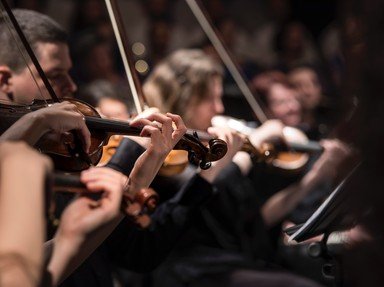Quiz Answer Key and Fun Facts
1. When musicians today reinterpret a song by another artist, it is usually called a cover version. Classical composers however did not just re-perform the works they quoted but changed and built new compositions upon other composers' themes. What is the term for a work based upon and developing a single theme (usually by another composer)?
2. Johannes Brahms has written several variations works named as such, but one of his works is essentially a single-movement variation set on several traditional songs, but uses a quite different name and format. What is it?
3. Being born into a Jewish family did not prevent Felix Mendelssohn from writing a symphony in praise of Luther's reformation. Which of Luther's chorales forms the basis of that symphony's triumphant finale?
4. Benjamin Britten's opus 34 is sometimes heard as "Variations and Fugue on a Theme of Purcell", but it is much better known with some narration added and given a very different title. What is it?
5. Folk music was one of the main inspirations of Gustav Mahler's work. In one of his symphonies, an entire movement is based on the French "Frère Jacques" canon. Which one is it?
6. One really good source for quoted material is of course one's own work. Which symphony quotes excerpts from the first three movements in its fourth and final movement?
7. In his "Symphonie Fantastique", Hector Berlioz quotes a famous religous work, Thomas of Celano's 13th century hymn "Dies Irae", in a rather profane setting. What is this hymn used to evoke?
8. Twelve-tone music is probably the one place where one would not expect any quotes from tonal works, yet one composer has quoted both Austrian folk music and a Bach choral in his twelve-tone technique violin concerto. Who was it?
9. Even modern composers using classical symphonic techniques are not immune to the urge to take some pretty obvious quotes from earlier classical works. James Horner, two-times Academy award winner for his opulent symphonic motion picture scores was unable to resist to lift the main theme for one of his movie soundtracks from the Rhenish Symphony Op. 97 by Robert Schumann. Which movie uses this obvious quote?
10. Famous musical composer Andrew Lloyd Webber ("Cats", "Evita", etc.) also has a classical-style work to his name in the album "Variations" for violoncello and rock band. It is based on a caprice by which famous composer known primarily for his violin works?
Source: Author
WesleyCrusher
This quiz was reviewed by FunTrivia editor
ertrum before going online.
Any errors found in FunTrivia content are routinely corrected through our feedback system.

